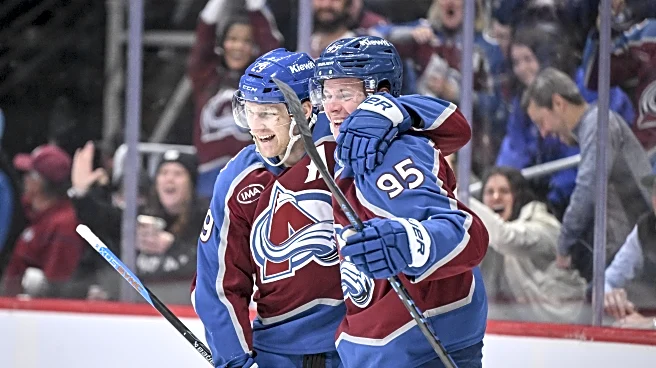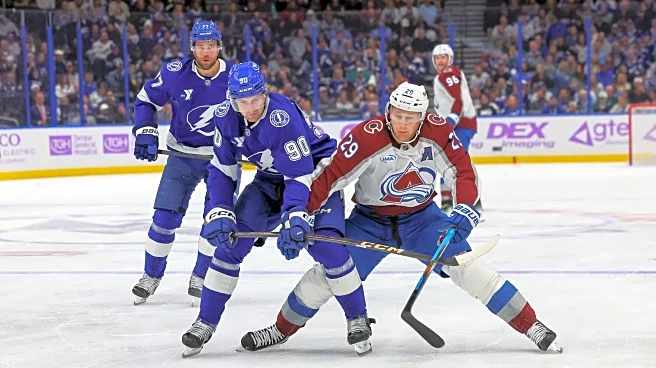One of the greatest concerns and topic of discussion on this young Colorado Avalanche season despite their sparkling record of 8-1-5 is the power play. With the disappointing results in the 2025 playoffs
and subsequent letting go of assistant coach Ray Bennett, it’s natural that there would be even more focus on how the new-look unit would fare once the 2025-26 season began. Early returns haven’t been great with a 17% output thus far but is there more to the story?

First, let’s look at the big picture. Over the past four seasons starting from 2021-2022 through last year (reflected in the above image from the top down), the power play has been remarkably consistent finishing each season within the 24% range. With that percentage, Colorado has ranked between 5th-8th in the league at the conclusion of each of those regular seasons. It is interesting to note Colorado received 45 fewer opportunities last season than the year prior and is reflected in the decline of power play time per game. Previously we discussed how the power play results have undermined the team in at least five of the last seven playoff defeats but the post season is not our focus here, though shortcomings in the regular season always get magnified in a short seven-game playoff series.
With only 14 games into the 2025-26 season it’s fair to expect the Avalanche power play to rebound from their current 17% conversion rate and show results similar to what they’ve experienced the past four years and finish at least in the top 10 of the league. The recent four goal eruption in the game at Ball Arena against the New Jersey Devils served as a reminder of what the talent on this Avalanche team can do and helped boost their confidence moving forward.
There is one missing link, however, and that’s Mikko Rantanen and his propensity to convert from anywhere on that right side of the ice. He was statistically Colorado’s best power play sniper year over year and we can’t write off that his departure might permanently alter the maximum capacity for this Avalanche power play unit. Martin Nečas as a right shot hasn’t been a direct replacement in the system while the coaching staff has experimented with who is taking the one-timer from the right side. Brock Nelson didn’t work in that spot and the current thinking is Victor Olofsson might be able to provide a threat from the right circle with encouraging early results and has scored the squad’s last two power play goals.

As always, we can’t just focus on results, especially with a small sample size and the reality of a new assistant coach and personnel gelling within an unfamiliar system, without a peek at the process. It’s pretty clear looking at the numbers that the issue with the current Avalanche power play lies in a lack of creating danger and quality chances. Though the last four game have improved these figures, there’s still work to be done.
It doesn’t take deep analysis to notice an Expected Goals For per 60 (xGF/60) at 6.77 and High Danger Corsi For per 60 (HD/60) at 15.81 as far off of Colorado’s typical output and the primary culprit of their struggles. These measures are also ranked 31st and by far 32nd in the league, respectively. The Avalanche typically enjoy a high shooting percentage (SH%) which causes them to convert more goals per 60 (GF/60) than their expected per 60 (XGF/60). There’s fair expectation for them to improve on their current 11.25 shooting percentage especially as shot attempt generation (CF/60), unblocked shot attempts (FF/60), and shots on goal (SF/60) are all improved from last season, which seemed to rely on an especially elevated shooting percentage that year. Following in line with the depressed danger this year, however, is the lagging scoring chance (SCF/60) generation of 48.78 per 60 also sitting currently at 27th in the NHL.
Going even further, which Avalanche players are contributing the most and least to the power play? The power play relies on players shooting from distance, which is not considered high danger, and the Avalanche typically enjoy a higher shooting percentage on the unit due to their superstar talents. Nathan MacKinnon and Cale Makar are volume shooters on the man advantage and have done so this season. Makar especially has been shooting more this season with 33.75 shot attempts per 60 (iCF/60) compared to last season’s 29.10 and remarkably he has not scored a power play goal yet in 2025-26. Having shot just under 20% on the power play last season with 12 goals on the power play it’s fair to say the superstar defenseman is due for some upwards regression. MacKinnon is in line with his previous shot rates of around 25 shot attempts per 60.
Where the high danger could be improved, though, is from those who typically lurk at the net-front. Both Val Nichushkin and Artturi Lehkonen haven’t been on the first unit the entire season and in turn haven’t contributed shots at their typical rates of around 15 iCF/60 and nine IHDCF/60, instead lagging behind around four on the high danger type of shots. Nichuskin is shooting at least 12 attempts per 60 with Lehkonen at nine. The Avalanche are also just missing other net-front personnel as Ross Colton was a great contributor in this area when he was hot last year and even Nikolai Kovalenko who had great underlying numbers on the power play in his brief stint with the team. Of the other options used this season Brock Nelson just isn’t great at generating shots and Gabe Landeskog hasn’t been dangerous.
More tweaks are needed to get this special teams unit back to where the Avalanche want it to be. There’s some encouraging signs and we’ve seen more success lately particularly with Victor Olofsson. We can also expect the team’s highest volume power play shooter Cale Makar to find the back of the net soon. The coaching staff needs to work more to get off the perimeter and find the right net-front personnel to create more danger if they want to truly turn their results around enough to rely on their power play making a difference in a positive manner in the postseason.













